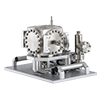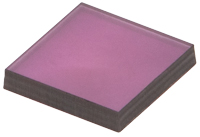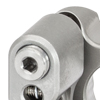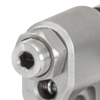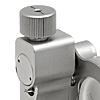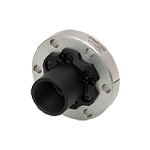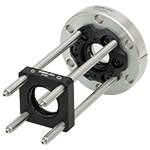Quantum Technologies

- Photonics Equipment for Quantum Technologies
- Next-Day Availability
SPDC810N
Narrowband Correlated Photon-Pair Source
DNVB14
Single-Crystal Diamond with
Nitrogen-Vacancy Centers
SPDMA
Single Photon Detection Module with Adjustable Gain
VC2H2S
UHV Compatible Fiber Feedthrough for Ø2.75" CF Flange
FPQFA-5
Tunable Narrow Bandpass Fabry-Perot Filter

Please Wait
Thorlabs' Equipment for Quantum Technologies
Thorlabs provides an array of photonics equipment for quantum technologies and applications including:- Single Photon Sources, Detectors, and Counting Device
- Single-Crystal Diamonds with Nitrogen-Vacancy Centers
- Balanced Detectors with Excellent Common Mode Rejection
- Polaris® Mounts for High Precision and Long-Term Alignment Stability
- ORIC® Piezoelectric Intertia Drive Stages
- Optical Reference Cavities with Crystalline Mirrors
- Tunable, Narrow Bandpass Fabry-Perot Filters
- Turnkey, Ultra-Low-Noise Laser Systems
- High-Vacuum Compatible Viewports and Windows
- Ultra-High Vacuum Compatible Fiber Feedthroughs
- Sealed Vapor Reference Cells
- Educational and Concept Demonstration Kits for Quantum Mechanics
The technological world is currently in the middle of a quantum revolution. Rapid developments in the fields of quantum communication, computing, imaging, sensing, and simulation have leveraged counter-intuitive quantum mechanical concepts such as the uncertainty principle, superposition, and entanglement to realize new scientific discoveries and world-changing technologies. As advancements in quantum technology continue to be made, Thorlabs remains dedicated to providing the components necessary for photonics-based quantum applications. For any inquiries related to custom solutions, please contact Tech Support.
A selection of our products that are well-suited for quantum applications are shown in the table below; please click on the image for further details. See the Publications tab for a partial and growing list of articles which have utilized Thorlabs' products for research on quantum technologies and related applications.
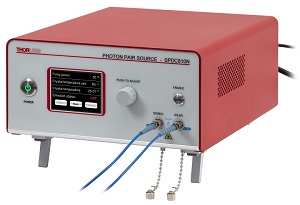
Click to Enlarge
SPDC810N Narrowband Photon-Pair Source shown with P1-780PMAR-2 patch cables (included) connected to the signal and idler outputs.

Click to Enlarge
The SPDC810N source's signal and idler photon output spectra overlap at 810 nm. The FWHM results in a photon bandwidth of <0.25 nm.

Click to Enlarge
SPDC810 Photon-Pair Source shown with P1-780PMAR-2 patch cables (included) connected to the signal and idler outputs.

Click to Enlarge
A second-order correlation measurement [g(2)(τ)] between signal and idler photons. The peak at τ = 0 confirms the generation of photon pairs. Data is valid for both sources.
Single Photon Sources
- Heralded Single-Photon Sources with g(2)(τ = 0) < 0.1
- Photon-Pair Generation by Spontaneous Parametric Down Conversion (Collinear Type-II)
- Photon Bandwidths Down to <0.25 nm
- Photon-Pair Generation Rates as High as >450 kHz
- Integrated 405 nm Pump Lasers
- Room Temperature Operation
Thorlabs' Correlated Photon-Pair Sources use spontaneous parametric down conversion (SPDC) to generate a pair of photons near 810 nm. Each source is self-contained, features an integrated 405 nm pump laser, and is capable of high-brightness photon-pair generation rates.
The SPDC810N narrowband source provides output with a 0.25 nm photon bandwidth, generates photon pairs at a rate of >100 kHz, and has a high-efficiency heralding ratio of >0.30. Comparatively, the SPDC810 source produces output with a wider photon bandwidth of ~10 nm, but generates photon pairs at a rate of >450 kHz and has an even higher heralding ratio of 0.45.
A zero-time delay second-order correlation function [g(2)(τ = 0)] value of <0.1 can be achieved with both sources, making them high-brightness heralded single-photon sources ideal for quantum optics applications.
The temperature of the SPDC810N Narrowband Source's nonlinear crystal can be adjusted to change the wavelength of the output photons by more than 8 nm, allowing for tuning in and out of degeneracy.
| Item # | SPDC810N | SPDC810 |
|---|---|---|
| Photon Bandwidth | <0.25 nm | ~10 nm |
| Max Pairs/Second | >100 kHz | >450 kHz |
| High-Efficiency Heralding Ratio (ηsi) | >0.30 | >0.45 |
| Wavelength Stability | ±0.1 nm | ±2.5 nm |
| Wavelength Tuning | >8 nm | No |
| PC Control | Yes | Yes |
| On-Unit Front Panel Control | Yes | No |

Click to Enlarge
The Photon Detection Efficiency (PDE) is shown here as a function of wavelength for the SPDMA module at both Max and Min Gain, the SPDMHx modules, and the SPCMxxA(/M) modules. The operating range of the SPDMA module is 350 nm - 1100 nm, for the SPDMHx modules it is 400 nm - 1000 nm, and the operating range of the SPCMxxA(/M) modules is 350 nm - 900 nm.
Single Photon Detectors
- Single Photon Detection or Counting Modules
- Low Dark Counts
- Detector Sizes of Ø20 µm, Ø50 µm, Ø100 µm, or Ø500 µm
- Active Quenching and Temperature Stabilization
Thorlabs offers single photon detectors and counting modules with a range of photon detection efficiencies (PDEs), detector sizes, gain options, and wavelength ranges. The SPDMA Single Photon Detection Module, designed for use from 350 to 1100 nm, features continuously adjustable gain and an SMA electrical connector from which the TTL output can monitored by an oscilloscope or external counter. Comparatively, the SPDMHx Fixed-Gain Single Photon Detection Modules, for use from 400 to 1000 nm, combine a higher PDE in the NIR (see the graph to the right) with low maximum dark count rates; the output TTL pulses are accessible via a LEMO connector.
Finally, the SPCMxxA(/M) Single Photon Counting Modules have an internal 31-bit photon counter, include a software package for controlling the detector and reading the output, and are intended for use from 350 to 900 nm.
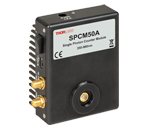
The SPCM50A counting module has a Ø50 μm active detector with an internal 31-bit photon counter and a software package.
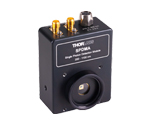
The SPDMA detector has a large Ø500 μm active detector, has adjustable gain, and provides an extended PDE into the NIR.
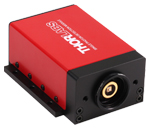
The SPDMH3 detector has a Ø100 μm active detector for free-space input beams, fixed gain, and a low dark count rate.
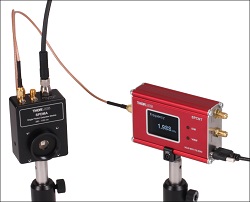
Click to Enlarge
The SPCNT photon displays the counts or frequency of the pulses from the SPDMA single photon detector.
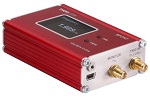
The SPCNT counting device can be operated and powered by PC via USB 2.0 connection or on its own with a 5 V power supply, such as the DS5 USB power supply.
Single Photon Counting Device
- Monitor Counts from Single Photon Detectors with Built-in Display or PC
- Compatible with the SPDMA and SPDMHx Single Photon Detectors
- Monitor and Save Results with Optical Power Monitor Software
- Monitor Output Connects to External Counters or Oscilloscope
- TRIG IN Connector to Gate via TTL Signal
The SPCNT Single Photon Counting Device can be used in conjunction with either the SPDMA detector or SPDMHx series of detectors to provide a full detection and counting solution. The counting device recognizes signal pulses originating from a connected single photon detector and shows the results numerically as counts or frequency on the built in display or on a connected PC for display and analysis.
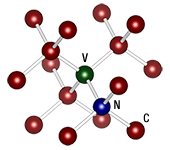
Click for Details
Nitrogen-vacancy centers are defects in the carbon lattice that are paired with adjacent vacancies.
| Typical Quantum Properties | |||
|---|---|---|---|
| Item # | DNVB1 | DNVB14 | ELSCxx |
| NV Center Density | 300 ppb | 4.5 ppm | <0.03 ppb |
| Spin Coherence Time T2* a | 1 µs | 0.5 µs | - |
| Spin Coherence Time T2 b | 200 µs | 10 µs | - |
| Diamond Grade | Quantum | Quantum | Electronic |
Diamonds with Nitrogen-Vacancy Centers
- Single-Crystal Diamonds Grown by Chemical Vapor Deposition (CVD)
- Quantum-Grade or Electronic-Grade Diamonds Available
- Three NV Center Densities Available:
- DNVB1: 300 ppb
- DNVB14: 4.5 ppm
- ELSC20, ESLC40, ELSC45: <0.03 ppb
These single-crystal diamonds, which are manufactured by Element Six using patented processes and offered by Thorlabs to enable quantum research advancements, are ideal for magnetic field sensing, RF detection, gyroscopes, masers, quantum demonstrations, quantum computing, quantum communication, and research applications. The quantum-grade diamonds are available with either 300 ppb or 4.5 ppm nitrogen-vacancy (NV) center densities. For users who wish to create their own defect centers, electronic-grade diamonds with <0.03 ppb NV concentration and a low background impurity level are available. These diamonds are also useful for applications such as fabricating ionizing radiation-resistant devices.

The PDB210A is designed for free-space inputs and features large active area, Ø5 mm Si detectors that are separated by 2.00" for easier beam alignment.
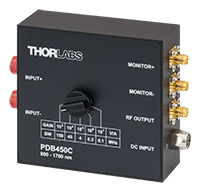
The PDB450C accepts FC/PC or FC/APC fiber inputs via a removable adapter. Output signals are transmitted through female SMA electrical ports.
Balanced Detectors
- Fiber-Coupled or Free-Space Options Available
- Si or InGaAs Detectors
- Models Available with Bandwidths up to 2.5 GHz
- Wavelength Ranges from 320 nm to 1700 nm
- Common Mode Rejection Ratios up to >35 dB, Depending on Model
Thorlabs' balanced photodetectors act as balanced receivers by subtracting the two optical input signals from each other, resulting in the cancellation of common mode noise. This allows small changes in the signal path to be extracted from the interfering noise floor. Each detector uses two well-matched Si or InGaAs detectors and an ultra-low-noise transimpedance amplifier for improved noise reduction. Our fiber-coupled balanced detectors with fast monitor outputs have FC/PC or FC/APC compatible adapters; on some models these adapters may be removed to allow for coupling of free-space light. We also offer balanced detectors designed for free-space applications that feature a larger active detector area, with detector diameters up to 5 mm available.
Our auto-balanced detector with avalanche photodiodes is optimized for applications with low optical input powers. This fiber-coupled detector is optimized for 1300 nm, and has an auto-balanced detection mode which automatically compensates for power differences between the two optical input signals that vary at a slower rate than a tunable cutoff frequency.
| Polaris® Optic Mount Selection Guide | ||
|---|---|---|
| Optic Retention Method (Click Image to Enlarge) |
Mount Type | Optic Sizes Available |
 Side Lock |
Kinematic | Ø1/2", Ø19 mm, Ø25 mm, Ø1", Ø1.5", Ø50 mm, Ø2", Ø3" |
| Fixed | Ø1/2", Ø19 mm, Ø1", Ø2" | |
 SM Threaded |
Kinematic | Ø1/2", Ø1", Ø2" |
 Low Distortion |
Kinematic | Ø1/2", Ø19 mm, Ø25 mm, Ø1", Ø1.5", Ø50 mm, Ø2", Ø4", Ø6" |
| Fixed | Ø1/2", Ø1", or Ø2" | |
 Glue In |
Kinematic | Ø1/2", Ø19 mm, Ø1" |
| Fixed | Ø1/2", Ø1", Ø2" | |
 Platform Mount |
Kinematic | Platform Size: 1.80" x 1.80" (45.7 mm x 45.7 mm) |
Polaris® Mirror Mounts
- Designed for Long-Term Beam Pointing Stability
- Minimal Temperature-Dependent Hysteresis
- Cleanroom and Vacuum Compatible
- Models for Optics from Ø1/2" to Ø6"
- Four Optic Retention Methods and Six Adjuster Types
Thorlabs' Polaris® line of products are the ultimate solution for quantum applications requiring stringent long-term alignment stability. Polaris mounts are available for optics as small as Ø1/2" and as large as Ø6". We offer fixed or kinematic Polaris mounts with various optic retention methods; please see the Selection Guide to the right. In addition, all of our Polaris mounts and accessories are cleanroom and vacuum compatible.
Polaris mounts with side lock retention mechanisms, available in kinematic or fixed varieties, feature a patented optic bore design with a monolithic flexure arm or a flexure spring and setscrew combination to hold the optic. These designs provide high holding force and pointing stability with minimal optic distortion. For applications where there may not be enough space behind the mount for horizontal access to the adjusters, we offer these mounts with integrated vertical-drive adjusters.
Our SM-threaded Polaris mounts feature an SM05-threaded (0.535"-40), SM1-threaded (1.035"-40), or SM2-threaded (2.035"-40) bore which allows a variety of optical components to be secured in the mount.
The Polaris low-distortion mirror mounts, available in kinematic or fixed varieties, use a patented three-point-contact faceplate design to provide long-term pointing stability while minimizing optic surface distortion. An indexed retention spring between the optic and retaining ring eliminates bending moments on the optic and ensures the force on the optic remains constant over large temperature changes.
Polaris glue-in mirror mounts, available in kinematic or fixed varieties, feature a mounting cell in which an optic can be permanently fixed with an optical adhesive. This mounting technique results in significantly less optical surface distortion than traditional methods based on setscrews or flexure mechanisms.
The Polaris kinematic platform mount provides a flat mounting surface with an array of nine 8-32 (M4) tapped holes and one #8 (M4) clearance hole for mounting optomechanical components. The clearance hole and two of the tapped holes each include two alignment pin holes, which allow the user to precisely align components mounted on these holes using dowel pins.
| Accessories for Polaris Mounts |
|---|
| Ø1" Posts for Polaris Mirror Mounts |
| Polaris Clamping Arm |
| Polaris 45º Adapter |
We also offer Polaris kinematic mounts with piezoelectric adjusters for applications requiring actively monitored, long-term alignment stability. We recommend driving the piezo actuators using our benchtop or Kinesis® K-Cube™ piezo controllers.
For custom mount configurations or custom orders, please contact Tech Sales.

Click to Enlarge
Three PD2(/M) stages can be mounted in an XYZ configuration using the PD2T(/M) and PD2Z(/M) adapters.
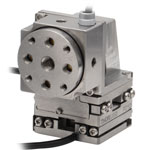
Click to Enlarge
XY + rotation stage created by mounting a PDR1C(/M) rotation stage on a PD1D(/M) XY stage using a PD1Z(/M) right angle bracket.
ORIC® Piezoelectric Stages
- Compact Stainless Steel Stages with Piezo Inerta Drives
- Ideal for OEMs and Set-and-Hold Applications that Require Relative Positioning with High Resolution
- Vertical Translation Stage with 4.5 mm Open or Closed-Loop Travel
- Linear Translation Stages with:
- 5 mm Travel, Open- or Closed-Loop Linear Stages
- 20 mm Travel, Open- or Closed-Loop Linear Stages
- 50 mm Travel, Open-Loop Linear Stage
- Open- or Closed-Loop Rotation Stages
- Vacuum-Compatible Versions Suitable for Pressures Down to 10-6 Torr
Thorlabs' ORIC® piezoelectric inertia drive stages (U.S. Patent 11,606,045) provide fast and stable piezo-controlled motion with no backlash in compact stainless steel packages. The piezo inertia drive is self-locking when the stage is at rest and no power is supplied to the piezo, making these stages ideal for set-and-hold applications that require nanometer resolution and long-term alignment stability.
Linear translation stages are available with 5 mm travel, 20 mm travel, or 50 mm travel. These stages support open-loop positioning along a single axis, with the PD1D(/M) monolithic XY stage offering two-axis translation with ≤2 mrad orthogonality. The PDX2(/M) and PDX1(/M) stages incorporate optical encoders to provide 5 mm and 20 mm, respectively, of open- and closed-loop operation in single-axis packages. Right-angle brackets and the stackable design of the stages allow for the assembly of XY, XZ, and XYZ configurations. Alternatively, the PDXZ1(/M) vertical stage provides 4.5 mm of vertical travel range upon which many of our linear stages may be mounted. The PDXZ1(/M) has a vertical load capacity of 1 kg (2.2 lbs) and can operate in both open- and closed-loop modes.
Our piezo drive rotation stages offer continuous 360° rotation. The PDR1 series stages provide open-loop operation in standard and compact sizes, while the PDXR1(/M) rotation stage includes an optical encoder which allows for open- and closed-loop operation. The rotation stages may be combined with ORIC 20 mm or 50 mm travel linear stages for XYΘ configurations, or with the PDXZ1(/M) vertical stage for ZΘ configurations.
We also offer vacuum-compatible versions of the 360° rotation stage and the 20 mm travel linear stage which can be used for pressures down to 10-6 Torr.
One of our piezo intertia controllers is required to operate these stages. Note that the piezo inertia drives cannot be driven using a standard piezo controller. Our K-Cube piezo controllers can be used to control either one (KIM001) or up to four (KIM101) piezo inertia drives in open-loop operation. The PDXC and PDXC2 piezo controllers support both open- and closed-loop operation. The PDXC controller provides three channels of control, while the PDXC2 controller provides a single channel of control in a compact design.
| ORIC® Piezo Inertia Stage Selection Guide | |||||
|---|---|---|---|---|---|
| Vertical Translation Stage | Linear Translation Stages | Rotation Stages | Vacuum-Compatible Stages | ||
 |
 |
 |
 |
 |
 |
| 4.5 mm Vertical Stage | 5 mm Translation Stage | 20 mm Translation Stages | 50 mm Translation Stage | Rotation Stages | Vacuum-Compatible Stages |
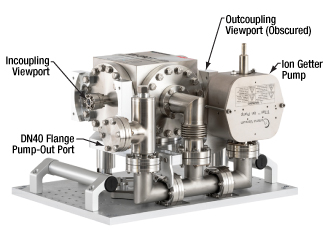
Click to Enlarge
XM-ORC Stainless Steel Vacuum Chamber and Ion Getter Pump
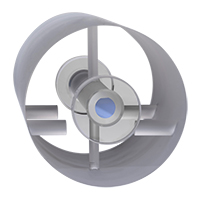
Click to Enlarge
Cylindrical Cavity with Optically-Contacted Crystalline-Coated Mirrors
Optical Reference Cavities
- High-Finesse Fabry-Perot Cavities for Active Frequency Stabilization
- Fused Silica, Crystalline-Coated Cavity Mirrors for Low Thermal Noise
- Includes an Ultra-Low Expansion (ULE®†) Cavity Spacer
- Available with 1064 nm, 1156 nm, 1397 nm, or 1550 nm Center Wavelength
- Integrated NTC and Peltier Elements for Active Temperature Control
- Includes Temperature Controller, Ion Getter Vacuum Pump, and Pump Controller
The XM-ORC Series of Optical Reference Cavities with Crystalline Mirrors are high-finesse Fabry-Perot cavities ideal for active frequency stabilization of a single mode CW laser. These optical cavities, designed together with Menlo Systems, integrate Thorlabs' high-performance supermirrors and are available with finesse values >200 000 at 1064 nm or >300 000 at 1156 nm, 1397 nm or 1550 nm. With a thermal noise Allan deviation (ADEV) limit as low as 1.6 x 10-16 and a low frequency drift of ~150 mHz/s, the XM-ORC reference cavities are ideal for applications that require cavity-stabilized lasers, such as high-resolution spectroscopy, quantum computing, and optical clocks. To inquire about custom reference cavities employing alternative geometries and operating at other center wavelengths, please see the full web presentation.
Optically Contacted Cavity
Each optical cavity includes a 12.1 cm cylindrical spacer made from ultra-low expansion (ULE) glass that is mounted horizontally on four support points within a sealed stainless steel vacuum housing. The incoupling and outcoupling cavity mirrors, which are concave and plano, respectively, are optically contacted and consist of Thorlabs' substrate-transferred crystalline coating (xtal stable™) on a fused silica substrate. ULE compensation rings are also included to ensure that room temperature operation will roughly correspond to the zero crossing of the thermal expansion coefficient for the assembled cavity.
†ULE is a registered trademark of Corning, Inc.
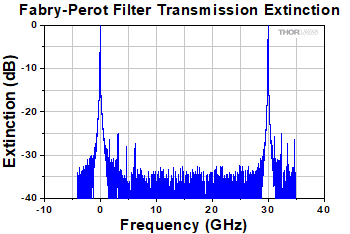
Click to Enlarge
Click Here for Data
The Fabry-Perot filter transmits fundamental resonance modes at 30 GHz FSR and suppresses light off-resonance typically above -30 dB, not including higher order modes.
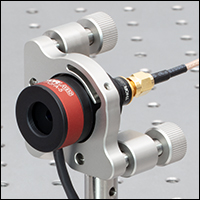
Click to Enlarge
The filters can be mounted in standard Ø1" kinematic mounts like the POLARIS-K1E shown here. A SM05-threaded mounted photodiode (Item # SM05PD2A) is attached to the filter's exit port for measurements up to 1100 nm (photodiode sold separately).
Tunable Narrow Bandpass Fabry-Perot Filters
- Operating Wavelength Range from 550 nm - 845 nm or 845 nm - 1300 nm
- Spectral Characterization of Quantum Emitters
- Free Spectral Range (FSR) of 30 GHz
- Transmission >80% for Low-Intensity Spectra Detection
- Finesse >300
- Resolution <100 MHz
- 5 mm Plano-Concave Cavity Mirror Separation
Thorlabs' FPQFA series Tunable Narrow Bandpass Fabry-Perot Filters are ideal for filtering low-light emission spectra over a narrow wavelength range of about 0.1 nm (for a 1 μm wavelength laser) or free spectral range (FSR) of 30 GHz. The Fabry-Perot filters are based on a non-confocal cavity composed of two high reflectivity mirrors, one planar and one spherical concave. The specific frequency transmitted by the cavity can be tuned by adjusting the length of the mirror separation using the built-in piezoelectric transducer. The filters have optical coatings for wavelength ranges from 550 - 845 nm (Item # FPQFA-5) and 845 nm - 1300 nm (Item # FPQFA-8), which are typical ranges for the photoluminescence spectra of Si1 and NV2 centers in diamond and InGaAs quantum dots3. The filter's >80% transmission, 30 GHz FSR, and <100 MHz resolution allow for the investigation of the spectral fine-structures of these low-light quantum emitters.
The filters can be used to select a part of the incoming light's spectrum, given by the Lorentzian-shaped transmittance characteristics, and use the spectrally filtered light down-stream in an optical system. Or the filters can be operated as scanning devices similar to the SA series FP interferometers, where the transmitted light is immediately measured using a photodiode, amplified by a transimpedance amplifier, and then displayed or recorded by an oscilloscope or data acquisition card. Several detector options are available from Thorlabs such as the SM05PD series mounted photodiodes, which can be attached to the filter's SM05-threaded exit port, or external detectors such as the DET series biased detectors, PDA series amplified detectors, or the APD series avalanche detectors.
References
- S. Lindner, A. Bommer, A. Muzha, A. Krueger, L. Gines, S. Mandal, O. Williams, E. Londero, A. Gali, and C. Becher "Strongly Inhomogeneous Distribution of Spectral Properties of Silicon-Vacancy Color Centers in Nanodiamonds", New J. Phys. 20, 115002 (2018)
- A. Savvin, A. Dormidonov, E. Smetanina, V. Mitrokhin, E. Lipatov, D. Genin, S. Potanin, A. Yelisseyev, and V. Vins, "NV– Diamond Laser", Nat Commun 12, 7118 (2021)
- A.B. Dey, M.K. Sanyal, I. Farrer, K. Permulal, D.A. Ritchie, Q. Li, J. Wu, and V. Dravid, "Correlating Photoluminescence and Structural Properties of Uncapped and GaAs-Capped Epitaxial InGaAs Quantum Dots", Sci Rep 8, 7514 (2018)
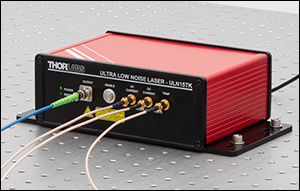
Click to Enlarge
The ULN15TK laser can be mounted to an optical table using four 1/4"-20 cap screws. The ULN15TK is pictured with a P3-1550PM-FC-5 PM fiber patch cable and three CA2912 SMA cables, which are connected to the optical output and analog modulation ports, respectively.
Narrow-Linewidth Single-Frequency Laser System
- Turnkey, C-Band, Single-Frequency Laser System
- Center Wavelength of 1550 nm ± 15 nm with 100 Hz Lorentzian Linewidth (Typ.)
- Typical Output Power of 120 mW
- Analog Modulation Inputs for DC Current, AC Current, and Laser Temperature
- 20 MHz Current Modulation Bandwidth
- Temperature-Stabilized Case for Long-Term Stability
- Integrated Fiber Isolator with >25 dB Isolation to Minimize Effects of Back-Reflected Light
- Remote Operation and Set-Point Adjustment with Command-Line Interface via USB 2.0
Thorlabs' ULN15TK Turnkey, Ultra-Low-Noise (ULN) Laser System is a ready-to-use laser system that integrates our ULN15PC laser, which has a patented fiber Bragg grating (FBG) based design, with a low-noise driver and temperature stabilization inside of a benchtop housing. This turnkey laser system provides single-frequency emission with relative intensity noise below -160 dBc/Hz and typical (Lorentzian) linewidths of 100 Hz. Factory-set for optimized performance, this laser offers typical optical output powers of 120 mW with a typical side mode suppression ratio (SMSR) of 70 dB. The narrow linewidth offered by this laser, especially when coupled to an external optical reference cavity, makes it ideal for use in the development of optical clocks and for neutral atom quantum compuation.
The optical output of this laser is fiber-coupled via an FC/APC bulkhead (2.0 mm narrow key) output connector. For best performance, we recommend connecting our PM FC/APC fiber patch cables that contain PM1550-XP fiber, such as the P3-1550PM-FC-1.
To achieve the narrow linewidth provided by the ULN15PC laser, this turnkey ULN laser includes drive electronics that are designed to minimize the current noise. The drive electronics also include a thermal stabilization system that controls the internal temperature settings of the laser and ensures long-term power and wavelength stability when the system is used in standard laboratory environments. A fiber isolator is also integrated at the output of the laser to minimize the impact of any back-reflected light on the laser.
Vacuum Components
- Ø2.75" CF Flange Viewports and Windows for High Vacuum
- Ø2.75" CF Flange Fiber Feedthrough for Ultra-High Vacuum
- Options for Ø1" Flat Windows and Ø1.5" Flat or Wedged Windows
- Compatible with Thorlabs' Line of Optomechanical Components
Thorlabs offers a growing line of high-vacuum compatible CF viewports, flanges, components, and hardware. High-vacuum (HV) systems are capable of reaching and maintaining pressures down to 10-8 Torr. Our Ø2.75" HV CF Viewports utilize Viton O-Ring seals to create an air-tight metal/glass seal, have a maximum bake temperature of 150 °C, and a maximum thermal gradient of 20 °C/min. Viewports designed for Ø1" windows are available from stock with one of three uncoated window substrates: sapphire (200 nm - 4.5 μm), CaF2 (180 nm - 8.0 μm), or UVFS (185 nm - 2.1 μm). The provided window may be replaced with any of our flat Ø1" windows that are 4.9 - 5.15 mm thick. We also offer viewports that are designed for Ø1.5" flat windows or Ø1.5" wedged windows. These viewports are available with UVFS windows that are either uncoated or have one of our four low-loss standard broadband antireflection coatings deposited on both optical surfaces.
Our Ø2.75" HV CF Viewports are also designed for compatibility with Thorlabs' line of optomechanics. Four 4-40 mounting holes enable compatibility with our 30 mm cage system, while internal SM threads allow connection by our lens tube systems. In addition, the viewports designed for Ø1" windows have four 2-56 mounting holes that allow our FiberPort collimators to be directly adapted to the viewport.

Click to Enlarge
Click for Data
This attenuation data was calculated as a function of wavelength for the fibers used in the UHV fiber feedthrough CF flanges.

Click to Enlarge
Ultra-High Vacuum Fiber Feedthrough CF Flange Cross-Section
We also offer a Ø2.75" fiber feedthrough CF flange to allow for optical coupling into ultra-high vacuum (UHV) systems down to 10-10 Torr. These feedthroughs incorporate a hermetically sealed step-index multimode fiber in a stainless steel shell, provide a low insertion loss of ≤2.3 dB, can handle optical powers up to 1 W, and have a maximum bake temperature of 250 °C. Feedthroughs are available with Ø100 μm, Ø200 μm, Ø400 μm, or Ø600 μm fiber cores with high OH fiber for wavelengths from 200 nm to 1200 nm or low OH fiber for wavelengths from 400 nm to 2400 nm. The fiber feedthroughs feature male SMA905 connectors on both sides; mating sleeves may be used to connect fiber patch cables. For the side of the feedthrough that is inside of the vacuum environment, the ADASMAV vacuum-compatible SMA-to-SMA mating sleeve can be used to connect a vacuum-compatible patch cable.
Copper gasket and mounting hardware sets for our Ø2.75" flanges are also available.

Click to Enlarge
The GC19100-I quartz vapor reference cell contains iodine (I) vapor and has wedged UVFS windows to eliminate etalon effects.
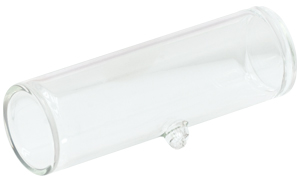
Click to Enlarge
The GC25075-RB vapor reference cell contains rubidium (Rb) and is fabricated from borosilicate glass, a rugged material known to resist chipping and cracking.
Vapor Reference Cells
- Sealed Glass Cells with Vapors of Specific Elements
- Borosilicate Glass Reference Cells
- Cesium (Cs)
- Potassium (K)
- Sodium (Na)
- Rubidium (Rb)
- Quartz Glass Reference Cells
- Cesium (Cs)
- Iodine (I)
- Rubidium (Rb)
- Enhanced Rubidium 87 (87Rb)
Thorlabs offers sealed glass reference cells that contain vapors of specific atomic elements or molecular compounds, each of which has a well-defined absorption spectrum. These cells may be used for the stabilization of laser frequencies, in quantum memory systems, and in magnetometry. They also have spectroscopic applications such as tunable diode laser calibration, the calibration of wavelength meters, and as elements in magneto-optical traps for atomic cooling. Both borosilicate and quartz reference cells are available with a range of standard fill materials. All of the cells that we offer are baked and evacuated to
10-8 Torr in order to remove contaminants prior to filling. Additionally, each cell is helium leak checked to ensure the longevity of the vapor cell. Custom reference cells can be manufactured upon request.
Our borosilicate glass reference cells are available from stock with cesium (Cs), potassium (K), sodium (Na), or rubidium (Rb) vapor. These cells are tested to ensure that the transmission through the cell exceeds 84% for light in the 350 nm to 2.2 μm range. The cells are 71.8 mm (2.83") long and have an outer diameter of 25.4 mm (1.00") with a >20.0 mm (>0.79") clear aperture.
Quartz reference cells are available from stock with cesium (Cs), iodine (I), rubidium (Rb), or enhanced rubidium 87 (87Rb) vapor. These cells feature UV fused silica windows for superior transmission in the UV spectral range. The windows, which are angled to compensate for beam offset, are designed with a 2 degree wedge so as to eliminate etalon effects. The outer diameter of the cells is 19.0 mm (0.75"). Cesium, rubidium and enhanced rubidium cells have a length of 75.0 mm (2.95"), while the iodine reference cell has a length of 100.0 mm (3.94").
Educational Kits
- Ideal for Educational, Demonstration, and Training Purposes
- Observe Fundamental Quantum-Optical Phenomena:
- Hands-On, Free-Space Setup to Generate and Investigate the Quantum-Mechanical Properties of Entangled Photon Pairs
- Classical Analog for Quantum-Mechanical Principles of Complementarity, Path Information, and Superposition
- Classical Analog to Demonstrate the Fundamentals of Quantum Cryptography
- Kits Include Necessary Hardware Plus Extensive Manual and Teaching Materials
- Easy to Assemble and Use
Thorlabs' line of educational products aims to promote physics, optics, and photonics by covering many classic experiments, as well as emerging fields of research and quantum technologies. Each educational kit includes the necessary components and a manual that contains both detailed setup instructions and extensive teaching materials. These kits are offered at the price of the included components, with the additional materials offered for free. Technical support from our educational team is available both before and after purchase.
Quantum Optics Educational Kit
Our quantum optics kit is designed for students to investigate the quantum properties of light first-hand in an open and accessible environment. From the type-I BBO crystal used to generate photon pairs to the state-of-the-art single-photon detectors, all elements employ free-space optics to clearly show where and when the measurement occurs. Several experiments can be performed with the kit, including single photon interferometry and single photon quantum eraser. Detailed step-by-step alignment instructions using an additional visible laser that mimics the single-photon emission cone ensure short setup times for each experiment. One particularly important aspect of the kit is to educate people about what constitutes a non-classical light source. Please note that the EDU-QOP1(/M) kit must be mounted on an optical table or breadboard, which is not included. If your lab does not already have a suitable one, we recommend the B2448FX (B60120AX) optical breadboard with the AV5(/M) damping feet.

An overview of Thorlabs' Quantum Optics Educational Kit, set up for the single photon quantum eraser experiment (breadboard not included in the kit).
Quantum Eraser Demonstration Kit
The quantum eraser demonstration kit illustrates the quantum-mechanical principles of complementarity, path information, and superposition. In the quantum-mechanical experiment, single photons are emitted into a Mach-Zehnder interferometer and, using linear polarizers, the photons are "marked" as having either a horizontal or vertical polarization state, indicating which side of the interferometer they have traveled through. The interference patten (wave property) and path information (particle property) cannot be measured simultaneously, since measuring the path information destroys the interference pattern. A third linear polarizer, placed after the beams have been recombined, "erases" the path information, thus restoring the interference pattern. Please note that, rather than using single photons as in the original quantum eraser experiment, the EDU-QE1(/M) kit uses a green continuous-wave laser light source that produces a beam that is visible to the naked eye. While the results may thus be explained by the classical properties of light polarization, the quantum-mechanical explanation serves as an analogy to the single photon experiment.
Quantum Cryptography Analogy Demonstration Kit
Our quantum cryptography kit is designed to demonstrate the fundamentals of quantum cryptography and the BB84 encryption protocol thorugh a series of experiments. In these experiments, users will learn how to encode messages in binary using the polarization state of light and then encrypt them using the BB84 protocol. Please note that the EDU-QCRY1(/M) analogy kit uses a pulsed laser source, i.e. classical light. While the sequence of the protocol is completely identical to the true quantum encryption system, it cannot be used as a perfect encryption system.
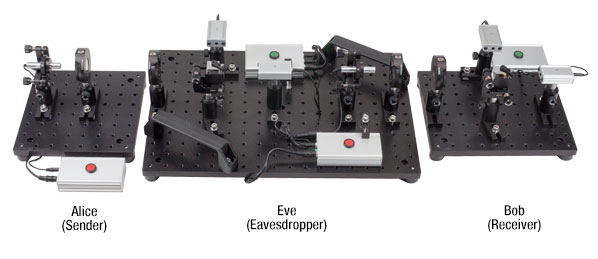
Click to Enlarge
Thorlabs' Quantum Cryptography Analogy Demonstration Kit illustrates the fundamentals of quantum cryptography and the BB84 encryption protocol.

Click for Details
Quantum Eraser Demonstration Optical Components and Beam Path
Select Publications
2023
A. Al-Juboori, H.Z.J. Zeng, M.A.P. Nguyen, X. Ai, A. Laucht, A. Solntsev, M. Toth, R. Malaney, and I. Aharonovich, "Quantum Key Distribution Using a Quantum Emitter in Hexagonal Boron Nitride," Adv. Quantum Technol. 6, 9 (2023)
» Products Cited: FBR-AH1, FBRP, EO-AM-NR-C1, HVA200, PBS052
C. Li, J. Jang, T. Badloe, T. Yang, J. Kim, J. Kim, M. Nguyen, S.A. Maier, J. Rho, H. Ren, and I. Aharonovich, "Arbitrarily structured quantum emission with a multifunctional metalens," eLight 3, 19 (2023)
» Products Cited: CPS635, LPVISE100-A, AHWP10M-600, TTL180-A
2022
Y. Bloom, I. Fields, A. Maslennikov, and G.G. Rozenman, "Quantum Cryptography—A Simplified Undergraduate Experiment and Simulation," Physics 4, 104-123 (2022)
» Products Cited: EDU-QCRY1(/M)
2021
D. Lowndes, S. Frick, A. Hart, and J. Rarity, "A low cost, short range quantum key distribution system," EPJ Quantum Technol., 8 15 (2021)
» Products Cited: WPQ05M-633, WPH05M-633, DDR25, FBH650-10
P. Bevington, R. Gartman, and W. Chalupczak , "Object detection with an alkali-metal spin maser," J. Appl. Phys. 130, 214501 (2021)
» Products Cited: PDB150A
S. Lee, S.-B. Lee, S.E. Park, H.-G. Hong, M.-S. Heo, S. Seo, J. Jeong, T.Y. Kwon, and G. Moon, "Compact modulation transfer spectroscopy module for highly stable laser frequency," Opt. Lasers Eng. 146, 106698 (2021)
» Products Cited: PDA10A2, POLARIS-K05S1, POLARIS-K1-2AH
J.S. Stuart, M. Hedges, R. Ahlefeldt, and M. Sellars, "Initialization protocol for efficient quantum memories using resolved hyperfine structure," Phys. Rev. Res. 3, L032054 (2021)
» Products Cited: FPL1009S
D. Main, T.M. Hird, S. Gao, E. Oguz, D.J. Saunders, I.A. Walmsley, and P.M. Ledingham, "Preparing narrow velocity distributions for quantum memories in room-temperature alkali-metal vapors," Phys. Rev. A 103, 043105 (2021)
» Products Cited: APD120
P.C. Fariña, B. Merkel, N.H. Valencia, P. Yu, A. Ulanowski, and A. Reiserer, "Coherent Control in the Ground and Optically Excited States of an Ensemble of Erbium Dopants," Phys. Rev. Appl. 15, 064028 (2021)
» Products Cited: PDB570C, GRIN2915, SMPF0215
J. Shi, W. Sun, H. Utzat, A. Farahvash, F.Y. Gao, Z. Zhang, U. Barotov, A.P. Willard, K.A. Nelson, and M.G. Bawendi, "All-optical fluorescence blinking control in quantum dots with ultrafast mid-infrared pulses," Nat. Nanotechnol. 16, 1355-1361 (2021)
» Products Cited: WP25H-K
F.M. Stürner, A. Brennis, T. Buck, J. Kassel, R. Rölver, T. Fuchs, A. Savitsky, D. Suter, J. Grimmel, S. Hengesbach, M. Förtsch, K. Nakamura, H. Sumiya, S. Onoda, J. Isoya, and F. Jelezko, "Integrated and Portable Magnetometer Based on Nitrogen-Vacancy Ensembles in Diamond," Adv. Quantum Technol. 4, 2000111 (2021)
» Products Cited: PM-S405-XP
S. Kanthak, M. Gebbe, M. Gersemann, S. Abend, E.M. Rasel, M. Krutzik, "Time-domain optics for atomic quantum matter," New J. Phys. 23, 093002 (2021)
» Products Cited: IO-5-1064-VHP, TC25FC-1064
2020
V.K. Sewani, H.H. Vallabhapurapu, Y. Yang, H.R. Firgau, C. Adambukulam, B.C. Johnson, J.J. Pla, and A. Laucht, "Coherent control of NV-centers in diamond in a quantum teaching lab," Am. J. Phys. 88, 1156–1169 (2020)
» Products Cited: LP520-SF15, DET025AFC(/M), MBT616D(/M), DMLP550, C280TMD-A
R.L. Patel, L.Q. Zhou, A.C. Frangeskou, G.A. Stimpson, B.G. Breeze, A. Nikitin, M.W. Dale, E.C. Nichols, W. Thornley, B.L. Green, M.E. Newton, A.M. Edmonds, M.L. Markham, D.J. Twitchen, and G.W. Morley, "Subnanotesla Magnetometry with a Fiber-Coupled Diamond Sensor", Phys. Rev. Applied 14, 044058 (2020)
» Products Cited: PDB450A, BSF10-A, FG400AEA, SM1NR05, C171TMD-B, C330TMD-B
H. Zheng, Z. Sun, G. Chatzidrosos, C. Zhang, K. Nakamura, H. Sumiya, T. Ohshima, J. Isoya, J. Wrachtrup, A. Wickenbrock, and D. Budker, "Microwave-Free Vector Magnetometry with Nitrogen-Vacancy Centers along a Single Axis in Diamond," Phys. Rev. Applied 13, 044023 (2020)
» Products Cited: PDA36A, PT3-Z8 (PT3/M-Z8), NR360S
S. Kulkarni, A. Uminska, J. Gleason, S. Barke, R. Ferguson, J. Sanjuán, P. Fulda, and G. Mueller, "Ultrastable optical components using adjustable commercial mirror mounts anchored in a ULE spacer," Appl. Opt. 59, 6999-7003 (2020)
» Products Cited: POLARIS-K1T1
S. Prabhakar, T. Shields, A.C. Dada, M. Ebrahim, G.G. Taylor, D. Morozov, K. Erotokritou, S. Miki, M. Yabuno, H. Terai, C. Gawith, M. Kues, L. Caspani, R.H. Hadfield, and M. Clerici, "Two-photon quantum interference and entanglement at 2.1 µm," Sci. Adv. 6, eaay5195 (2020)
» Products Cited: PDA10DT(-EC)
M. Kutas, B. Haase, P. Bickert, F. Riexinger, D. Molter, and G. von Freymann, "Terahertz quantum sensing," Sci. Adv. 6, eaaz8065 (2020)
» Products Cited: CS2100M-USB
2019
S. Ecker, F. Bouchard, L. Bulla, F. Brandt, O. Kohout, F. Steinlechner, R. Fickler, M. Malik, Y. Guryanova, R. Ursin, and M. Huber, "Overcoming Noise in Entanglement Distribution," Phys. Rev. X 9, 041042 (2019)
» Products Cited: DET10A(/M)
2018
J.A. Zielinska and M.W. Mitchell, "Atom-resonant squeezed light from a tunable monolithic ppRKTP parametric amplifier," Opt. Lett. 43, 643-646 (2018)
» Products Cited: PDB450A
S. Wei, D. Wang, J. Lin, and X. Yuan., "Demonstration of orbital angular momentum channel healing using a Fabry-Pérot cavity," Opto-Electron. Adv. 1, 180006 (2018)
» Products Cited: SA200-5B, SA201(-EC), MDT694B
P.-J. Tsai and Y.-C. Chen, "Ultrabright, narrow-band photon-pair source for atomic quantum memories," Quantum Sci. Technol. 3, 034005 (2018)
» Products Cited: SA200-8B, PDA100A(-EC)
S. Tamura, K. Ikeda, K. Okamura, K. Yoshii, F.-L. Hong, T. Horikiri, and H. Kosaka, "Two-step frequency conversion for connecting distant quantum memories by transmission through an optical fiber," Jpn. J. Appl. Phys. 57, 062801 (2018)
» Products Cited: HL63142DG
P. Vernaz-Gris, K. Huang, M. Cao, A.S. Sheremet, and J. Laurat, "Highly-efficient quantum memory for polarization qubits in a spatially-multiplexed cold atomic ensemble," Nat. Commun. 9, 363 (2018)
» Products Cited: BD40
A. Dréau, A. Tchebotareva, A. El Mahdaoui, C. Bonato, and R. Hanson, "Quantum Frequency Conversion of Single Photons from a Nitrogen-Vacancy Center in Diamond to Telecommunication Wavelengths," Phys. Rev. Appl. 9, 064031 (2018)
» Products Cited: S122C
2017
B. Docters, J. Wrachtrup, and I. Gerhardt, "Two Step Excitation in Hot Atomic Sodium Vapor," Sci. Rep. 7, 11760 (2017)
» Products Cited: C220TME-A, PM200, S130C, PDA36A(-EC)
K.I. Gerasimov, M.M. Minnegaliev, S.A. Moissev, R.V. Urmancheev, T. Chanelière, and A. Louchet-Chauvet, "Quantum memory in an orthogonal geometry of silenced echo retrieval," Opt. Spectrosc. 123, 211-216 (2017)
» Products Cited: DET100A(/M), APD102A(/M)
2016
A. Kinos, Q. Li, L. Rippe, and S. Kröll, "Development and characterization of high suppression and high étendue narrowband spectral filters," Appl. Opt. 55, 10442-10448 (2016)
» Products Cited: PDB150A
S.L. Portalupi, M. Widmann, C. Nawrath, M. Jetter, P. Michler, J. Wrachtup, and I. Gerhardt, "Simultaneous Faraday filtering of the Mollow triplet sidebands with the Cs-D1 clock transition," Nat. Commun. 7, 13632 (2016)
» Products Cited: GT10-B
R.A. Jensen, I.-C. Huang, O. Chen, J.T. Choy, T.S. Bischof, M. Loncar, and M.G. Bawendi, "Optical Trapping and Two-Photon Excitation of Colloidal Quantum Dots Using Bowtie Apertures," ACS Photonics 3 (3), 423-427, (2016)
» Products Cited: MAX301(/M), DET50B(/M)
B. Sotillo, V. Bharadwaj, J.P. Hadden, M. Sakakura, A. Chiappini, T.T. Fernandez, S. Longhi, O. Jedrkiewicz, Y. Shimotsuma, L. Criante, R. Osellame, G. Galzerano, M. Ferrari, K. Miura, R. Ramponi, P.E. Barclay, and S.M. Eaton, "Diamond photonics platform enabled by femtosecond laser writing," Sci. Rep. 6, 35566 (2016)
» Products Cited: MBT401D(/M), S1FC808, TLS001-635
A. Sipahigil, R.E. Evans, D.D. Sukachev, M.J. Burek, J. Borregaard, M.K. Bhaskar, C.T. Nguyen, J.L. Pacheco, H.A. Atikian, C. Meuwly, R.M. Camacho, F. Jelezko, E. Bielejec, H. Park, M. Loncar, and M.D. Lukin, "An integrated diamond nanophotonics platform for quantum-optical networks," Science 354, 847-850 (2016)
» Products Cited: PDA100A(-EC), LCC3112H/M, LP705-SF15, GVS012(/M)
2014
I.I. Vlasov, A.A. Shiryaev, T. Rendler, S. Steinert, S.-Y. Lee, D. Antonov, M. Vörös, F. Jelezko, A.V. Fisenko, L.F. Semjonova, J. Biskupek, U. Kaiser, O.I. Lebedev, I. Sildos, P.R. Hemmer, V.I. Konov, A. Gali, and J. Wrachtrup, "Molecular-sized fluorescent nanodiamonds," Nat. Nanotechnol. 9, 54-58 (2014)
» Products Cited: HL6548FG, HL6738MG
2013
M. Sabooni, S. Tornibue Kometa, A. Thuresson, S. Kröll, and L. Rippe, "Cavity-enhanced storage—preparing for high-efficiency quantum memories," New J. Phys. 15, 035025 (2013)
» Products Cited: PDB150A
2012
K.F. Reim, J. Nunn, X.-M. Jin, P.S. Michelberger, T.F.M. Champion, D.G. England, K.C. Lee, W.S. Kolthammer, N.K. Langford, and I.A. Walmsley, "Multipulse Addressing of a Raman Quantum Memory: Configurable Beam Splitting and Efficient Readout," Phys. Rev. Lett. 108, 263602 (2012)
» Products Cited: APD210
2009
A. Walther, A. Amari, S. Kröll, and A. Kalachev, "Experimental superradiance and slow-light effects for quantum memories," Phys. Rev. A 80, 012317 (2009)
» Products Cited: PDB150A
| Posted Comments: | |
| No Comments Posted |
 Products Home
Products Home



















